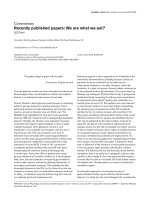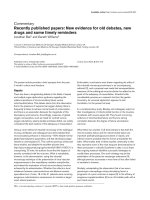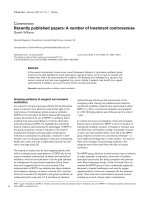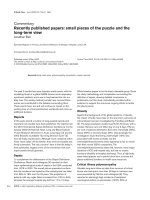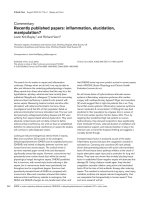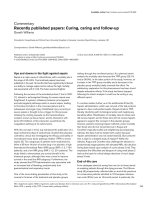Báo cáo y học: "Recently published papers: Take your predictions with a drop of saline … and breathe deeply before turning on your phone" ppt
Bạn đang xem bản rút gọn của tài liệu. Xem và tải ngay bản đầy đủ của tài liệu tại đây (37.06 KB, 3 trang )
210
CURB = Confusion, Urea, Respiratory rate, Blood pressure; ICU = intensive care unit; MET = medical emergency team; NIV = non-invasive ventilation.
Critical Care August 2004 Vol 8 No 4 Semple and Forni
He that would know what shall be
must consider what has been.
Thomas Fuller, MD, Gnomologia (1732)
Scoring systems are beloved by some intensivists. They can
provide a means by which patients may be compared
between facilities, therefore enabling sensible trials to be
conducted. They may also play a role in directing treatment
plans for patients. However, the Holy Grail for many
enthusiasts remains their potential use as prognostic tools
among the critically ill in an attempt to predict the future. One
would hope that clinical acumen also plays a role in
determining treatment and the study by Rocker and
coworkers [1] is somewhat reassuring in this respect. That
prospective study, which included some 851 mechanically
ventilated patients, was performed to evaluate the predictive
ability of, and outcomes associated with, daily clinician
estimates of a probability of intensive care unit (ICU) survival
under 10%. The usual baseline characteristics were
recorded, together with daily Acute Physiology and Chornic
Health Evaluation II score and Multiple Organ Dysfunction
Score. After morning ward rounds the attending physician
and each bedside nurse were asked to predict the clinical
probability of ICU survival as one of the following: under
10%, 10–40%, 41–60%, 61–90%, or over 90%.
Just over 35% of the cohort died on the ICU. Of those
patients deemed to have a greater than 10% chance of
surviving ICU, 87.8% survived. Of those with an expected
survival chance of under 10%, 29% did actually survive their
ICU stay, although no data are given regarding whether they
survived their hospital stay. The physicians tended to have a
bleaker outlook than the nursing staff, but when both
observations were combined this was, unsurprisingly, a more
powerful predictor. Indeed, the clinical prediction was more
powerful than illness severity, use of inotropes and
vasopressors, or organ dysfunction. However, the group
thought to have a poor outlook was also more likely to have
some form of life support withdrawn. Therefore, it appears
from this study that clinical assessments of prognosis remain
strongly influential in determining outcome.
A study conducted by Ewig and coworkers [2] takes
prediction a step further (or back?) onto the medical wards.
In a 3-year prospective study of 696 sequential patients
Commentary
Recently published papers: Take your predictions with a drop of
saline … and breathe deeply before turning on your phone
David J Semple
1
and Lui G Forni
2
1
Specialist Registrar Renal Medicine, Department of Critical Care, Worthing General Hospital, Lyndhurst Road, Worthing, West Sussex, UK
2
Consultant Physician, Department of Critical Care, Worthing General Hospital, Lyndhurst Road, Worthing, West Sussex, UK
Correspondence: David J Semple,
Published online: 3 July 2004 Critical Care 2004, 8:210-212 (DOI 10.1186/cc2915)
This article is online at />© 2004 BioMed Central Ltd
Abstract
Early recognition of sick patients with a poor prognosis, and the rapid institution of appropriate therapy
are tenets of good medical management across all specialties. Here we highlight five recent papers
that aid us in achieving such goals in and around the intensive care unit (ICU). Both score-generating
clinical tools and clinical acumen are championed for identifying the sick, while appropriate, early
intervention in acute deterioration is shown to be beneficial, before and after ICU admission. Saline or
albumen for resuscitation? The answer became clearer in May, as did what to do about all those
mobile phones…
Keywords artificial respiration, cellular phone, predictive value of tests, resuscitation, risk assessment, risk
factors, severity of illness index
211
Available online />(after exclusions) with community-acquired pneumonia,
several tools for assessment of severity and prediction of
mortality were validated. These included the original and
modified American Thoracic Society guidelines, the original
and modified British Thoracic Society guidelines, the
Pneumonia Severity Index and the less cumbersome CURB
(Confusion, Urea, Respiratory rate, Blood pressure) index
based on recent studies reported by Lim and coworkers [3,4].
The modified American Thoracic Society guidelines were
superior to the other tools in predicting the severity of
community-acquired pneumonia, as judged by need for ICU
care. Fulfilling two out of three minor criteria (systolic blood
pressure <90 mmHg; multilobar [>2 lobes] involvement; and
arterial O
2
tension [in mmHg]/fractional inspired O
2
ratio
<250) or one of two major criteria (requirement for
mechanical ventilation; and septic shock) gave positive and
negative predictive values for ICU admission of 87% and
94%, respectively. However, prediction of mortality was
better with either the Pneumonia Severity Index or CURB
index. The simple CURB score (1 point for each of confusion
of acute onset; serum urea >7 mmol/l, respiratory rate
≥30 breaths/min; and diastolic blood pressure ≤ 60 mmHg or
systolic blood pressure <90 mmHg) was found to be a very
quick and useful method for rapidly assessing the risk for
dying. Scores of 0, 1–2 and 3–4 were associated with
mortality rates of 3%, 21% and 56%, respectively. This may
well prove to be a useful ward/emergency room tool, but
even the very best predictive tool is just a guide.
Leading on from these studies, the paper by Bellomo and
coworkers [5] appreciates that part of the role of the ICU is to
prevent patients deteriorating before ICU admission or indeed
preventing admission. This approach has attracted much
attention of late, and Bellomo and coworkers performed a
prospective controlled trial in order to assess whether the
introduction of a medical emergency team (MET; slightly
confusing for the exercise physiologists among us!) may reduce
adverse outcomes following surgery. In this setting, the MET
consisted of the duty intensive care fellow and a designated
ICU nurse. Specialist availability was provided on site for
12 hours but was also available after hours if needed. Any
member of the hospital clinical staff could activate the MET
team (including social workers), and the average response time
was a phenomenal 1.7 min. This figure we find particularly
astounding, and reflects Australia’s resurgence as a sporting
nation. Of particular interest are the criteria for initiation of the
MET team. In an era in which increasingly complicated scoring
systems are being employed to identify those ‘at risk’, the
authors must be applauded for using straightforward
parameters that focus on drastic acute changes but also
include the sensible caveat that a staff member is worried about
a patient. Once again experience is the key.
So what of the MET? The results reported are impressive.
The introduction of the MET resulted in a relative risk
reduction for adverse outcomes of 57.8%. The most striking
reductions were in renal failure requiring renal replacement
(relative risk reduction 88.5%), respiratory failure (79.1%)
and severe sepsis (74.3%). Somewhat surprisingly, there
was also a dramatic reduction in the risk for acute stroke.
Unsurprisingly, this all translated into reductions in the
number of postoperative deaths and in the length of stay. The
authors themselves outlined the flaws in this study, some of
which are almost impossible to circumvent. The study was
not double blinded, placebo controlled, or randomized. Also,
considerable effort was made to educate those on the wards
with respect to the criteria needed to activate the MET, which
might have raised awareness on the wards. Also, it is
common that in one’s daily practice on the ICU one is called
to review patients on the wards in a more informal ‘MET-like’
arrangement. It is not clear whether such arrangements were
in hand previously, but we assume so. These criticisms
should not detract from the findings, although we would be
interested to see whether the improvements are sustained. The
power of these results is that they perhaps illustrate that the
speed by which a patient is reviewed by individuals equipped
to deal with any physiological deterioration may dictate the
eventual outcome. Now, if we could just get some more juniors
and get rid of the European working time directive …
The theme of early intervention in deteriorating patients was
continued in a study conducted by Esteban and coworkers
[6]. That prospective, randomized, multicentre trial of 221
patients compared non-invasive ventilation (NIV) for
respiratory failure, within 48 hours of elective extubation,
versus standard medical therapy. Those investigators
demonstrated that not only did NIV fail to prevent the need
for reintubation, but that it also delayed reintubation and
resulted in increased mortality. Reintubation rates were 48%
in both groups (relative risk 0.99, 95% confidence interval
0.76–1.30). Median time to reintubation was 12 hours for the
NIV group, as compared with 2.5 hours for the standard
therapy group (P = 0.02), and most importantly mortality
almost doubled in the NIV group (25% versus 14%; relative
risk 1.78, 95% confidence interval 1.03–3.20; P = 0.048).
The bulk of the deaths in the NIV group occurred in those
who required reintubation (21 out of 28 deaths), suggesting
that the delay in reintubation in this group may account for
these findings. The moral of this study may be that if you are
thinking of reintubation, then get on with it. It seems that
things only get worse with time, and biting the bullet early
helps to limit the risks.
The choice of resuscitation fluid for those patients the
athletic Australians cannot keep off the ICU was made a little
easier in May, thanks to the SAFE (Saline versus Albumin
Fluid Evaluation) study group [7]. In the largest multicentre,
double blind, randomized controlled trial on this issue to date,
7000 patients were assigned to receive either 0.9% saline or
4% albumin solution for fluid resuscitation during their first
28 days on the ICU. Contrary to the original Cochrane meta-
212
Critical Care August 2004 Vol 8 No 4 Semple and Forni
analysis that sparked the whole debate on this issue, those
investigators found no difference in 28-day mortality between
patients resuscitated with saline and those with albumin. No
significant differences were identifiable in the rate of new
single or multiorgan failure (assessed using Sequential
Organ Failure Assessment score), in the number of days
spent on the ICU, or hospital stay. There were also no
differences in the time spent on mechanical ventilation or in
the duration of renal replacement therapy between the two
treatment groups. The study was pragmatically planned,
dictating only the fluid resuscitation of the patients, leaving
clinicians free to manage all other aspects of the patients’
care as they saw fit. This freedom was controlled by
stratification of randomization such that individual units
treated equal numbers of patients in each group. Preplanned
subgroup analysis suggested a benefit from albumin in septic
patients, which was balanced by a detrimental effect in
trauma patients with significant head injury. However, as the
authors highlighted, further studies should look into such
specific groups before any changes are introduced. With
either fluid being shown to be equally safe and effective, the
initial choice (for the moment at least) would seem to be
down to the clinician (managers?) involved.
Finally, although British Telecom in the UK spent much
money several years ago telling those of us on this small
island that it is ‘good to talk’, it appears that this may not be
true in the immediate vicinity of a ventilated patient, at least
on the telephone. Shaw and coworkers [8] demonstrated
that some urban myths might be true; 50% of ventilators they
tested malfunctioned when in close (<30 cm) proximity to a
transmitting mobile phone. Thankfully, only one model
stopped completely. With the ever-increasing prevalence of
wireless technology (computer networks, personal digital
assistants, phones, pagers and radios, among other devices),
better shielding by the manufacturers of ICU equipment from
electromagnetic interference would seem prudent. The
manufacturers of the machine that stopped completely have
already introduced hardware and software upgrades that
remedy the problem. However, in the meantime, perhaps we
should keep mobile phones and ventilators at a safe
distance, or at least keep the conversation short.
Competing interests
None declared.
References
1. Rocker G, Cook D, Sjokvist P, Weaver B, Finfer S, McDonald E,
Marshall J, Kirby A, Levy M, Dodek P, et al.: Clinician predictions of
intensive care unit mortality. Crit Care Med 2004, 32:1149-1154.
2. Ewig S, de Roux A, Bauer T, Garcia E, Mensa J, Niederman M,
Torres A: Validation of predictive rules and indices of severity
for community acquired pneumonia. Thorax 2004, 59:421-427.
3. Lim WS, Macfarlane JT, Boswell TC, Harrison TG, Rose D,
Leinonen M, Saikku P: Study of community acquired pneumo-
nia aetiology (SCAPA) in adults admitted to hospital: implica-
tions for management guidelines. Thorax 2001, 56:296-301.
4. Lim WS, van der Eerden MM, Laing R, Boersma WG, Karalus N,
Town GI, Lewis SA, Macfarlane JT: Defining community
acquired pneumonia severity on presentation to hospital: an
international derivation and validation study. Thorax 2003,
58:377-382.
5. Bellomo R, Goldsmith D, Uchino S, Buckmaster J, Hart G, Opdam
H, Silvester W, Doolan L, Gutteridge G: Prospective controlled
trial of effect of medical emergency team on postoperative
morbidity and mortality rates. Crit Care Med 2004, 32:916-
921.
6. Esteban A, Frutos-Vivar F, Ferguson ND, Arabi Y, Apezteguia C,
Gonzalez M, Epstein SK, Hill NS, Nava S, Soares MA, et al.: Non-
invasive positive-pressure ventilation for respiratory failure
after extubation. N Engl J Med 2004, 350:2452-2460.
7. Finfer S, Bellomo R, Boyce N, French J, Myburgh J, Norton R: A
comparison of albumin and saline for fluid resuscitation in the
intensive care unit. N Engl J Med 2004, 350:2247-2256.
8. Shaw CI, Kacmarek RM, Hampton RL, Riggi V, Masry AE, Cooper
JB, Hurford WE: Cellular phone interference with the operation
of mechanical ventilators. Crit Care Med 2004, 32:928-931.


